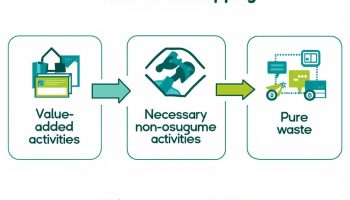
Supply Chain Strategy and Competitive Strategy Alignment
Supply chain strategy and competitive strategy alignment creates a powerful foundation for business success through a structured, intentional approach to operations management. By synchronizing these strategies, organizations can leverage their supply networks to gain market advantages while ensuring that operational decisions support broader business objectives.
Why Supply Chain Strategy Alignment Drives Competitive Advantage
Supply chain strategy alignment is essential for modern enterprises aiming for sustainable growth in complex markets. When supply chain capabilities directly support competitive positioning—whether through cost leadership, differentiation, or market focus—companies can respond more effectively to market demands, optimize resources, and create barriers to competition.
This strategic integration transforms the supply chain from a purely operational function into a strategic asset that boosts profitability, improves customer satisfaction, and provides the agility needed to capitalize on emerging opportunities before competitors can react.
Your supply chain strategy isn’t just a logistical framework—it’s a competitive weapon. When you align these elements correctly, you’ll create synergies that enhance your market position while streamlining internal operations. Effective alignment allows you to translate high-level business goals into practical, day-to-day supply chain actions that consistently deliver value.
The right alignment helps you identify which supply chain capabilities matter most for your competitive strategy, allowing you to focus investments where they’ll generate the greatest returns. This targeted approach ensures your supply chain directly contributes to your competitive advantage rather than simply maintaining operations.
Companies with aligned supply chain and competitive strategies outperform their peers by as much as 20% in key performance indicators, such as on-time delivery and customer satisfaction.
Aligning Supply Chain Strategy with Competitive Strategy
Aligning your supply chain strategy with competitive strategy forms a crucial foundation for business success. This alignment transforms your supply chain from a simple cost center into a genuine competitive differentiator. The right supply chain architecture directly supports your organization’s market position—whether you’re focusing on cost leadership, differentiation, or a targeted strategy.
Creating Effective Supply Chain Strategy Alignment
To create effective supply chain strategy alignment, you’ll need to start by understanding your market position and defining clear customer value propositions. Your supply chain must be intentionally designed to fulfill these promises while supporting your core business goals. Companies that successfully connect these strategies gain substantial advantages in operational efficiency, market responsiveness, and bottom-line results.
By following a structured approach to alignment, you can transform your supply chain into a strategic asset that reinforces your competitive advantages. This process requires careful planning, cross-functional collaboration, and a deep understanding of both your customers’ needs and your organization’s strategic direction.
1. Define Your Competitive Strategy
Aligning your supply chain strategy with your competitive strategy creates a powerful foundation for business success. Begin by identifying your core business objectives, which will drive all supply chain decisions. Your supply chain strategy should directly support these goals, whether they focus on market expansion, cost reduction, or innovation.
Next, analyze your market position to understand where you stand relative to competitors. This assessment helps you identify which supply chain capabilities need strengthening to gain competitive advantage. Market analysis reveals opportunities where an optimized supply chain can differentiate your offerings.
Determine which competitive advantage your organization will pursue: cost leadership, differentiation, or focus. Each requires a distinct supply chain approach. Cost leaders need efficient, streamlined operations; differentiation strategies require agile, responsive supply chains; and focused strategies need specialized supply chain capabilities to serve niche markets. Strategic planning ensures your supply chain aligns with these competitive priorities.
Finally, map customer value propositions to understand what your customers truly value. This mapping helps you design a supply chain that delivers on these promises. Consider creating visual representations of how your risk appetite affects supply chain decisions that support your competitive strategy.
2. Assess Current Supply Chain Capabilities
Before designing your optimal supply chain strategy and competitive strategy alignment, you need to thoroughly understand your current capabilities. Conducting a comprehensive audit of existing supply chain processes reveals where you stand and what needs improvement. This audit should examine each link in your chain from raw materials to final delivery.
Next, evaluate your supplier relationships to determine which partners add value and which create bottlenecks. Strong supplier relationships are foundational to any effective supply chain strategy. Consider factors like reliability, cost-efficiency, flexibility, and alignment with your competitive goals.
Measuring key performance metrics provides quantitative evidence of your supply chain’s effectiveness. Track metrics like:
- Order fulfillment rates
- Inventory turnover
- Cash-to-cash cycle time
- Perfect order rates
These metrics help gauge performance against industry benchmarks.
Finally, identify gaps and bottlenecks that prevent optimal supply chain performance. Look for:
- Outdated technology systems
- Communication breakdowns
- Process redundancies
- Capacity constraints
- Skills shortages
These insights from your capability assessment will inform how you align your supply chain strategy with your broader competitive objectives, ensuring you build on strengths while addressing weaknesses that impede competitive advantage.
Expert Insight: To enhance your supply chain strategy, begin with a comprehensive audit of current capabilities, identifying strengths and weaknesses across all processes. Evaluate supplier relationships and measure key performance metrics to pinpoint bottlenecks. Use these insights to align your supply chain with competitive objectives for improved efficiency and effectiveness.
3. Design Supply Chain Architecture for Competitive Advantage
Once you’ve aligned your supply chain strategy and competitive strategy fundamentals, it’s time to architect your supply chain structure. Begin by selecting the appropriate supply chain model that supports your competitive positioning. Your choice between responsive, efficient, or hybrid models should directly reflect your organization’s strategic priorities.
Configure your network design by mapping facility locations, transportation routes, and distribution centers to optimize cost and service level trade-offs. This critical aspect of supply chain technology strategy requires balancing proximity to customers with operational efficiency.
Establish inventory policies that reflect your competitive strategy—whether just-in-time for cost leadership or buffer stock for differentiation through service reliability. Your policies must balance working capital constraints against customer service requirements.
Develop a distribution strategy that determines how products move through your network, including:
- Direct shipping vs. hub-and-spoke models
- Cross-docking opportunities
- Last-mile delivery options
- Outsourcing vs. in-house logistics
Finally, set service level agreements (SLAs) that codify your supply chain performance expectations and strategic planning priorities. These SLAs should directly support your competitive positioning while remaining operationally achievable.
Expert Insight: To gain a competitive advantage, align your supply chain architecture with your strategic priorities by choosing the right model, optimizing network design, and establishing tailored inventory and distribution strategies. Ensure service level agreements reflect both performance expectations and operational feasibility, reinforcing your overall competitive positioning.
4. Implement Strategic Enablers for Supply Chain Strategy Alignment
Aligning your supply chain strategy with your competitive strategy requires implementing key enablers that bridge planning with execution. Start by deploying relevant technologies like AI and analytics to enhance your supply chain visibility and decision-making capabilities. These technologies serve as the foundation for a data-driven supply chain that can adapt to changing market conditions.
Building strategic partnerships is equally crucial for your supply chain strategy. Identify partners who complement your capabilities and enhance project collaboration across your value chain. Strong partnerships create resilience and flexibility, allowing you to respond more effectively to competitive pressures.
Developing talent and capabilities must be prioritized to execute your supply chain strategy. Invest in training programs that align employee skills with your strategic objectives. Your workforce needs both technical expertise and strategic understanding to implement your competitive strategy effectively through supply chain operations.
Create a robust governance structure with clear roles, responsibilities, and decision rights. This structure ensures proper oversight of your supply chain strategy implementation and establishes risk management protocols to protect against disruptions. Remember that governance isn’t just about control—it’s about enabling agile decision-making that supports your competitive positioning in the marketplace.
Expert Insight: To align your supply chain strategy with competitive goals, leverage AI and analytics for enhanced visibility and agility. Foster strategic partnerships to bolster collaboration and resilience. Invest in workforce training to ensure technical skills match strategic objectives and establish a governance structure that enables effective decision-making and risk management.
5. Tracking KPIs for Supply Chain Strategy Alignment
Effective monitoring of your supply chain strategy and competitive strategy alignment requires establishing relevant metrics. The right KPIs help you evaluate if your supply chain is delivering the intended competitive advantages. Start by selecting indicators that directly connect to your supply chain strategy objectives. For most organizations, these include cost efficiency, service levels, inventory turnover, and market responsiveness metrics that reflect your supply chain’s contribution to competitive advantage.
Consider these essential categories for monitoring supply chain strategy alignment:
- Operational metrics (cycle times, fulfillment rates)
- Financial indicators (cost per order, working capital)
- Customer experience measures (on-time delivery, perfect order rate)
- Innovation metrics (new product introduction success)
- Sustainability indicators (carbon footprint, ethical compliance)
Effective KPI monitoring requires the right technology infrastructure to collect and analyze data in real-time, allowing you to respond quickly to emerging issues.
Measuring Competitive Impact Through Supply Chain Performance
Your supply chain strategy directly impacts your competitive position in the marketplace. To measure this impact, compare your supply chain performance against industry benchmarks and key competitors. This comparison reveals where your supply chain creates differentiation or cost advantages that translate to market success.
Evaluate how supply chain improvements correlate with:
- Market share changes
- Customer retention rates
- Profit margin improvements
- New market entry success
- Competitive response times
Regular competitive analysis should include supply chain capabilities as a core component. This helps you understand if your supply chain strategy is truly creating competitive advantages or if adjustments are needed to maintain market leadership.
Conducting Strategic Supply Chain Reviews
Regular strategy reviews ensure ongoing alignment between your supply chain strategy and competitive strategy. Schedule quarterly reviews to assess performance against objectives and annual comprehensive evaluations to reconsider fundamental strategic choices. During these reviews, gather cross-functional teams to evaluate how well supply chain initiatives support your competitive positioning.
Key questions to address in your strategic reviews include:
- Is our supply chain delivering the expected competitive advantages?
- Have market conditions changed, requiring supply chain adjustments?
- Are new technologies emerging that could enhance our competitive position?
- What feedback are we receiving from customers about our supply chain performance?
Strategic review processes should be formalized with clear ownership, documentation, and follow-up mechanisms to ensure accountability.
Making Data-Driven Supply Chain Adjustments
When misalignments between your supply chain strategy and competitive strategy emerge, take a structured approach to making corrections. Begin by identifying the root causes of gaps using data analysis rather than assumptions. Then prioritize changes based on their potential impact on your competitive position and feasibility of implementation.
Consider these approaches for effective adjustment:
- Incremental improvements for minor misalignments
- Targeted transformations for specific capability gaps
- Complete redesign when fundamental shifts occur in your competitive landscape
Use a combination of historical data and predictive analytics to model the potential impact of changes before implementation. This reduces risk and increases the likelihood that supply chain strategy adjustments will strengthen your competitive position.
Fostering Supply Chain and Competitive Strategy Integration
Creating a culture of continuous improvement ensures that supply chain strategy and competitive strategy remain aligned over time. Establish cross-functional teams responsible for identifying and implementing improvements that enhance competitive advantages. Empower frontline employees to suggest changes that could strengthen alignment between daily operations and strategic goals.
Develop these continuous improvement capabilities:
- Formal innovation processes for supply chain enhancements
- Regular skills development for supply chain professionals
- Knowledge sharing mechanisms across departments
- Supplier collaboration programs focused on strategic outcomes
Organizations with strong continuous improvement programs create supply chains that not only support but actively drive competitive strategy, adapting quickly to market changes and creating sustainable advantages that competitors struggle to replicate.
Expert Insight: To effectively align your supply chain and competitive strategies, establish relevant KPIs that reflect core objectives such as cost efficiency and service levels. Regular reviews and data-driven adjustments will enhance performance. Foster a culture of continuous improvement to ensure your supply chain actively supports your strategic goals.
Strategic Alignment: Maximizing Competitive Advantage
Aligning supply chain strategy with competitive strategy creates a powerful foundation for business success by ensuring operational capabilities directly support market positioning. This strategic alignment follows a structured five-step approach—defining competitive strategy, assessing capabilities, designing architecture, implementing enablers, and tracking performance—allowing organizations to transform their supply chains from cost centers into drivers of sustainable competitive advantage.
Key Implementation Steps
- Define your competitive strategy (cost leadership, differentiation, or focus) and align supply chain capabilities accordingly
- Conduct a comprehensive audit of current supply chain processes and supplier relationships
- Select an appropriate supply chain model (responsive, efficient, or hybrid) based on your competitive priorities
- Implement strategic enablers including AI technologies, analytics, and strategic partnerships
- Establish relevant KPIs that measure supply chain performance against competitive objectives
- Schedule quarterly reviews to assess performance and annual evaluations to reconsider strategic choices
- Develop a governance structure with clear roles and decision rights for supply chain management
- Create a culture of continuous improvement focused on enhancing competitive advantages
- Use data-driven approaches to identify and correct misalignments between strategies
- Foster cross-functional collaboration to strengthen strategic integration throughout the organization
Frequently Asked Questions
- How does supply chain strategy directly impact competitive advantage? Supply chain strategy impacts competitive advantage by enabling cost leadership through efficient operations, supporting differentiation through responsive and reliable service, or enabling focus strategies through specialized capabilities tailored to specific market segments.
- What metrics best indicate successful supply chain and competitive strategy alignment? The most effective metrics include operational indicators (order fulfillment rates, cycle times), financial measures (cost per order, working capital efficiency), customer experience metrics (perfect order rate, on-time delivery), and market performance indicators (market share changes, customer retention rates).
- How often should organizations review their supply chain strategy alignment? Organizations should conduct quarterly performance reviews against strategic objectives and annual comprehensive evaluations to reconsider fundamental strategic choices and alignment, especially when market conditions change significantly.
- Can the same supply chain strategy work for different competitive strategies? No, supply chain strategies must be tailored to specific competitive approaches—cost leaders need efficient, streamlined operations; differentiation strategies require agile, responsive supply chains; and focused strategies need specialized capabilities for niche markets.
- What role does technology play in supply chain and competitive strategy alignment? Technology serves as a critical enabler by providing visibility, enhancing decision-making capabilities, and creating a data-driven foundation that allows supply chains to adapt quickly to changing market conditions and support competitive positioning.






